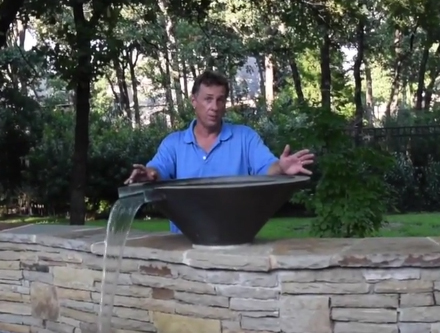#26: Water Bowls

Water bowls emerged not long ago as a key element in the Watershaping Industry’s ongoing campaign to bring dimension, sound and vitality to residential backyards and commercial settings. They go a long way toward masking traffic noise, which is cool, but even in a space that’s perfectly quiet, they offer up soothing sounds while bringing a sense of variety and visual stimulation to projects of just about any size or extent.
As with the many similar add-on features used with pools – from planters to fire bowls as well as combined water/fire and water/plant features – the designer has a responsibility to consider the big picture and make certain everything works with respect to scale and other factors related to the setting.
This is why, in considering the use of water bowls, I run through a quick mental checklist. I start by thinking about the various shapes and sizes of available bowls, then settle on one or more models that best suit the space. I also think about color (or patina, as with the copper bowls discussed in the video linked below), vertical profile and compatibility with the materials of construction used to support them.
I also consider some form of flow-altering system that will let the bowls serve as an extension of a client’s mood, from a brisk, noisier flow for a party atmosphere to something softer and quieter to accompany a relaxing meal. It also helps to consider having them completely turn off in the event full quiet is desired – or a big wind rises.
I’ll also move the bowls around within a design, deciding whether to make them central or peripheral, higher or lower, close by or relatively distant. And there are safety and anchoring issues to be considered depending on whether or not the bowl will be within ready reach of a bather within the pool.
Whatever decisions I ultimately make, my desire is to include however many bowls I determine is appropriate and fully integrate them as design elements rather than allow them to become the focus of too much attention: Indeed, there’s an editing step that should occur in every design process where items should be moved in and out of the design to make certain they really belong.
The big point to be made here is that, more and more often, these water bowls are parts of a design that have what it takes to break through the planning stage and become part of the final product: They’re versatile, affordable and generally easy to install – and they very often are just what it takes to bring a dose of “special” to a wide variety of settings. If you haven’t already, give them a look: Your clients will be grateful!
To see the water bowls discussed in this text, click here.
Mike Farley is a landscape designer with more than 35 years of experience and is currently a designer/project manager for Claffey Pools in Southlake, Texas. A member of Genesis 3’s Society of Watershape Designers since 2012, he holds a degree in landscape architecture from Texas Tech University and has worked as a watershaper in both California and Texas.










